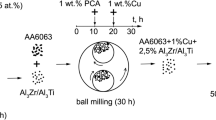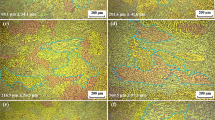Abstract
Al-Si alloy A356 was modified by TiC nanoparticles. First, the nanoparticles were mechanochemically activated together with aluminum powder. Next, the activated particles were hot extruded in a home-made extruder. Finally, nanoparticles thus prepared in the aluminum matrix were added to the liquid Al-Si alloy, which was then cast into sand molds. A comparison of the microstructure and mechanical properties of the modified alloy thus produced with those of the alloy without the nanoparticles demonstrated that the grain size of the modified alloy decreased. The mechanical properties determined after T6 heat treatment indicated unusual behavior, where the elongation of the modified alloys increased by 20 to 50 pct in different regions of the cast, while the tensile strength remained unchanged and the hardness increased by 18 pct. An electron microscopy study revealed concentration of dislocations near grain boundaries in the modified alloy samples. These grain boundaries serve as obstacles to dislocation motion. It was therefore concluded that the improvement in the mechanical properties of the aluminum alloy modified by TiC nanoparticles was caused by the grain-size-strengthening mechanism.







Similar content being viewed by others
References
C. Limmaneevichitr and W. Eidhed: Mater. Sci. Eng. A, 2003, 349, pp. 197-206.
P.L. Schaffer and A.K. Dahle: Mater. Sci. Eng. A, 2005, 413-414, pp. 373-378.
P.S. Mohanty and J.E. Gruzleski: Acta Metall. Mater., 1995, 43 (5), pp. 2001-2012.
C. Wang, M. Wang, B. Yu, D. Chen, P. Qin, M. Feng, and Q. Dai: Mater. Sci. Eng. A, 2007, 459, pp. 238-243.
A. Daoud and M. Abo-Elkhar: J. Mater. Proces. Tech., 2002, 120, pp. 296-302.
Shang-Nan Chou, Jow-Lay Huang, Ding-Fwu Lii, and Horng-Hwa Lu: J. Alloys Compd., 2006, 419, pp. 98-102.
Y. Han, K. Le, J. Wang, D. Shu, and B. Sun: Mater. Sci. Eng. A, 2005, 405, pp. 306-312.
X. Jian, H. Xu, T.T. Meek, and Q. Han: Mater. Lett., 2005, 59, pp. 190-193.
S. Zhang, Y. Zhao, X. Cheng, G. Chen, and Q. Dai: J. Alloys Compd., 2009, 470, pp. 168-172.
H.T. Lu, L.C. Wang, and S.K. Kung: J. Chinese Foundrymen’s Association, 1981, 29, pp. 10-18.
G.K. Sigworth and M.M Guzowski: ASF Transactions, 1985, 93, pp. 907-912.
L. Clapham and R.W. Smith: J. Cryst. Growth, 1986, 79(1-3), pp. 866-73.
L. Qiyang, L. Qingchun, and L. Qifu: Acta Metall. Mater., 1991, 39 (11), pp. 2497-2502.
M.C. Flemings, R.G. Riek, and K.P. Young: Mater. Sci. Eng., 1976, 25, pp. 103-117.
P. Kapranos, P.J. Ward, H.V. Atkinson, and D.H. Kirkwood: Mater. Design, 2000, 21, pp. 387-394.
S.N. Chou, J.L. Huang, D.F. Lii, and H.H. Lu: J. Alloys Compd., 2006, 419, pp. 98-102.
H.M. Guo, X.J. Yang, and J.X. Wang: J. Alloys Compd., 2009, 485 (1-2), pp. 812-816.
Liao BC, Park YK, and Ding HS: Mater. Sci. Eng. A, 2011, 528 (3), pp. 986-995.
S.A. Sajjadi, M. Torabi Parizi, H.R. Ezatpour, and A. Sedghic: J. Alloys Compd., 2012, 511, pp. 226-231.
R.Z. Valiev, I.V. Alexandrov, Y.T. Zhu, and T.C. Lowe: J. Mater. Res., 2002, 17 (1), pp. 5-8.
S.X. Li and G.R. Gui: J. Appl. Physics, 2007, 101 (8), pp. 83525-83530.
M. Tiryakioglu, J. Campbell, and J.T. Staley: Mater. Sci. Eng. A, 2003, vol. 361, pp. 240-48.
E.O. Hall: Proc. Phys. Soc. B, 1951, 64, pp. 747-753.
K. Lee, Y.N. Kwon, and S. Lee: J. Alloys Compd., 2008, 461, pp. 532-541.
Acknowledgment
The current study was supported by the Chief Scientist of the Israel Ministry of Industry, Trade, and Labor (The MAGNET Program Grant No. 41889). The authors would like to thank Ms. Natalia Litvak for her help in the SEM studies.
Author information
Authors and Affiliations
Corresponding author
Additional information
Manuscript submitted March 17, 2013.
Rights and permissions
About this article
Cite this article
Borodianskiy, K., Kossenko, A. & Zinigrad, M. Improvement of the Mechanical Properties of Al-Si Alloys by TiC Nanoparticles. Metall Mater Trans A 44, 4948–4953 (2013). https://doi.org/10.1007/s11661-013-1850-4
Published:
Issue Date:
DOI: https://doi.org/10.1007/s11661-013-1850-4




